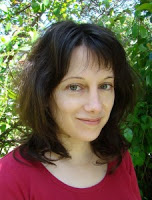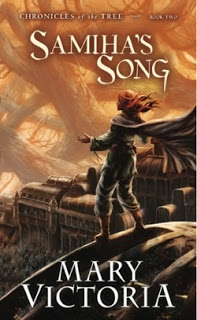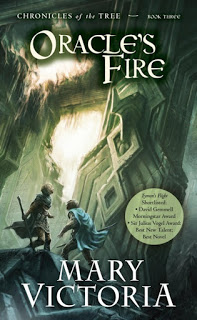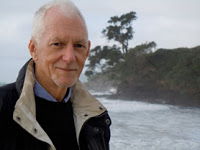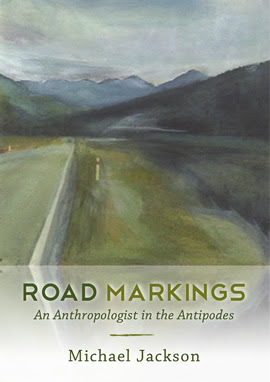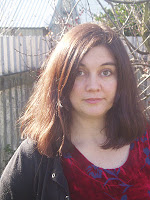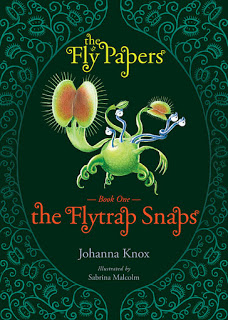So far, Mary Victoria has lived in seven countries and settled permanently in none. This is becoming problematic for customs officials trying to make sense of her passport. She has been at various times in her life a nanny, an animator, and a writer of fantasy. She is currently employed as a domestic servant to four cats, and has delusions of adequacy.
Mary, I recently finished reading Oracle’s Fire, the third volume in your Chronicles of the Tree trilogy, and I’m happy to say that I enjoyed the trilogy very much. What was the seed (pun intended) of the massive Tree which is the setting for most of the trilogy?
I’m happy you enjoyed it! I become quite nervous when other writers read my stuff… I keep feeling I have to go extra lengths to please them, because they know better. The idea that I’m a fraud and that fellow authors are going to see straight through me persists, even after three books. Maybe it’ll still be there when I’ve written twenty…
The genesis of the Tree was a complex affair, a result of many influences. I love the work of Japanese director Hayao Miyazaki. If you’re familiar with his films, you’ll know he made one named ‘Laputa,’ which figures a large tree floating through the sky, entwined with a fabled city. The image was so odd and fantastical and it moved me. Another direct source of inspiration was of course the Norse myth of Yggdrasil, the original world tree that holds Midgard, the world of men in its branches.
I honestly can’t remember the point at which I thought, “I’m going to write a story which takes place in the branches of a gigantic tree the size of a mountain range.” But I do know that once I had the world, the story was a natural – forgive me – outgrowth.
The action, and the resolution, of the trilogy are closely tied up with the philosophical and religious issues that you explore in considerable depth in these novels. To what extent did these themes emerge as your wrote the books, and to what extent to they derive from your own prior thought and experience?
Many emerged as I wrote. I did approach these books in an organic way, allowing themes to develop from the inside out. But I also have a lifelong fascination with philosophy, religion and belief systems of all kinds. I find religions can bring out both the best and worst in us, and as such they are brilliant tools for story… From genuine altruism to the most horrific crimes and prejudices, you can lay it all at the door of belief.
I was interested in the relationship between fantasy, particularly End Times fantasies, and religion. It seems to me both tap into a very peculiar quirk in the human psyche – that need for a messiah, a saviour who will judge between the righteous and the wicked, and bring all nastiness to an end with a big full stop. I’ve tried to gently unravel this idea through my stories, starting with the usual trumpeting prophecies and ending with what I hope is something more ‘real’. It’s still a magical ‘real’, of course!
The books also show a clear concern for the environment and a dislike of war and its effects – both on those who wage it and their victims. I like the way that you wove these issues in without the books coming across as at all “preachy” – a balance I sometimes find difficult. How did you manage it?
You’ve brought up an interesting point. I imagine I must have put some readers off with my refusal to resolve everything through a big fat war. But I’ve read so many stories where a hero’s strength is measured by external conflict… It’s fine. It works. But I wanted to see what happened when my protagonists were tested in other ways. The most powerful characters in my books appear to ‘give up’ in order to achieve a more long-term victory. I like that inversion of expected norms.
I don’t know if I managed to stay away from the preachy. I certainly tried, mainly by allowing characters to come to realisations in their own time and way, or fail to come to realisations altogether. I didn’t know who would come through until the very end.
Do you, and does your publisher, regard these as Young Adult novels? I ask because a number of the leading characters suffer severe physical punishment over the course of the books, especially in Samiha’s Song, including rape and some savage beatings. Why was it important to include these scenes, and were they a problem for your publisher?
Actually, Voyager let me know they’d decided to pitch the books to an adult market after I’d finished writing the first book and was starting on the second. I sold what I thought was going to be a YA trilogy and found I was being asked to write sequels aimed at an older audience… hence the darker tone in the last two books.
But it does makes sense. Tymon’s Flight was always at the older end of YA, anyway. I wouldn’t give it to anyone under twelve. And as the action progresses, the characters pit themselves against some powerful forces. Considering the reality of religious persecution, I think they get off fairly lightly.
I know from talking to you during the writing of the trilogy that you had to meet some very tight deadlines to produce the second and third books, both of which feature long journeys under adverse conditions. Do you think the travails of the writing process affected the narrative, or were the plots of Samiha’s Song and Oracle’s Fire in place long before you wrote them?
Oh God, this question made me laugh. Yes! The process had an effect. As a matter of fact I wrote the scene you refer to above, in which a character receives a beating, with my arms on ice packs due to tendonitis. Something like method acting for writers…
Seriously, I wouldn’t do that again. I’m not that sort of writer!
Changing tack a little, writers are usually keen to hear about the path other writers take to getting an agent and to publication. How did these milestones come about in your case?
It took a while for me. Basically five years from the time I first sent an incomplete draft to my then-prospective agent, to the point at which she felt she could take me on and sell the trilogy. I started the first book in 2004. I finally signed with my agent and sold Tymon’s Flight to Harper Voyager in 2009.
I was, and still am, very lucky to have a supportive agent interested in my development as a writer. She guided me through that period of apprenticeship, patiently waiting until there was something there she could sell. People are quite vocal at the moment about self-publishing and bypassing the agent process. I know that personally, I need the mentoring and editorial input.
I think I’m right in saying that your poem Rapunzel, which I selected for inclusion in Issue 2 of the online speculative poetry magazine Eye to the Telescope, was your first published poem. Is there more Mary Victoria poetry on the way?
Now, where did I put my black beret…
You may see more poetry. But if you do, it’ll be written in the context of my next project. So the poetry is moved by a surrounding story, rather than existing in its own right… does that make sense? Some of the pieces will work on their own, some won’t. Some of them will be pure doggerel! I’m not sure that’s a great advertisement.
If you are willing to tell us, what else are you working on at the moment?
I can say a few things without being obliged to kill you. The new work isn’t epic fantasy, though it doesn’t qualify as straight realism, either. It’s contemporary fiction, or almost-contemporary fiction, being set in the island of Cyprus where I grew up. There is a slight magical realist twist. Like everything I do it is inspired by myth, but here the myth is buried deep. You won’t see any light sabres.
It’s fun to discover a new way of writing, and a challenge. The going is slow but I’m enjoying myself tremendously.
Thanks, Mary! It’s been great to find out some more about the sources of your writing.
Thanks so much for having me over, Tim!
Book availability details
You can find out more about Mary Victoria and her books on www.maryvictoria.net
